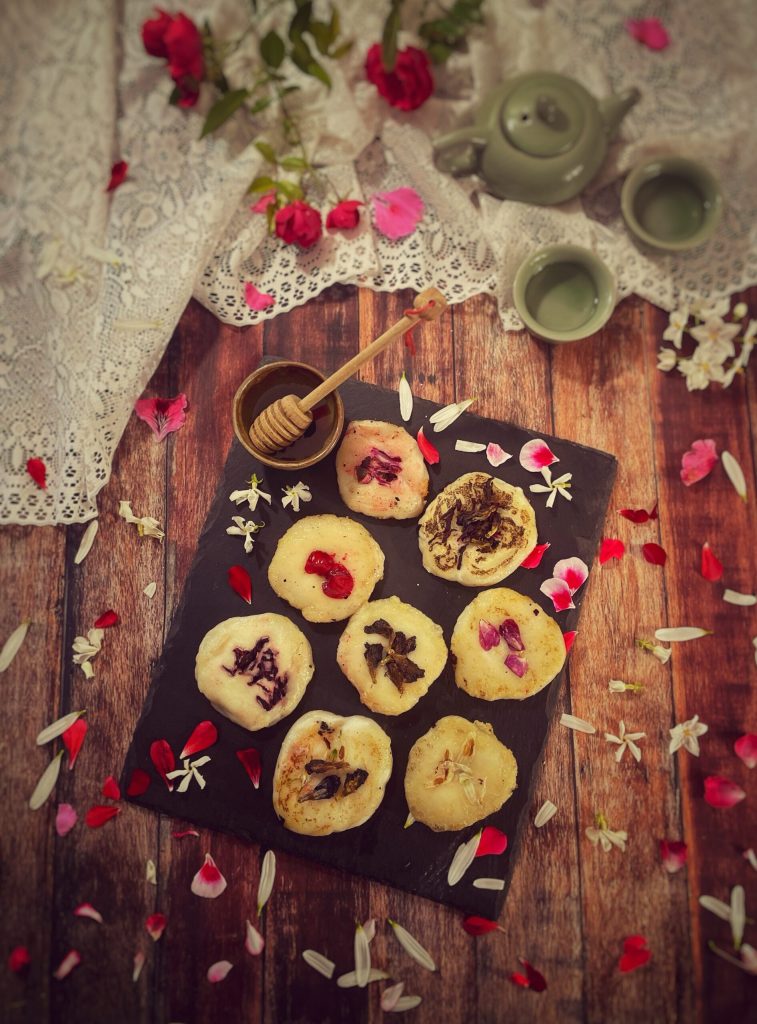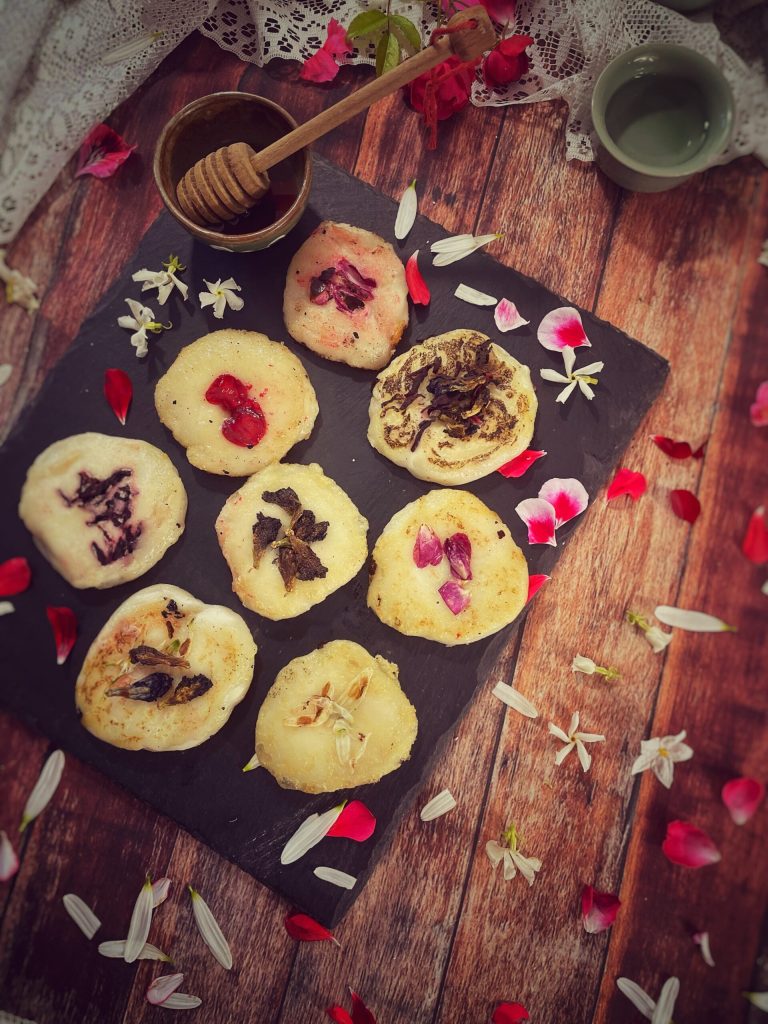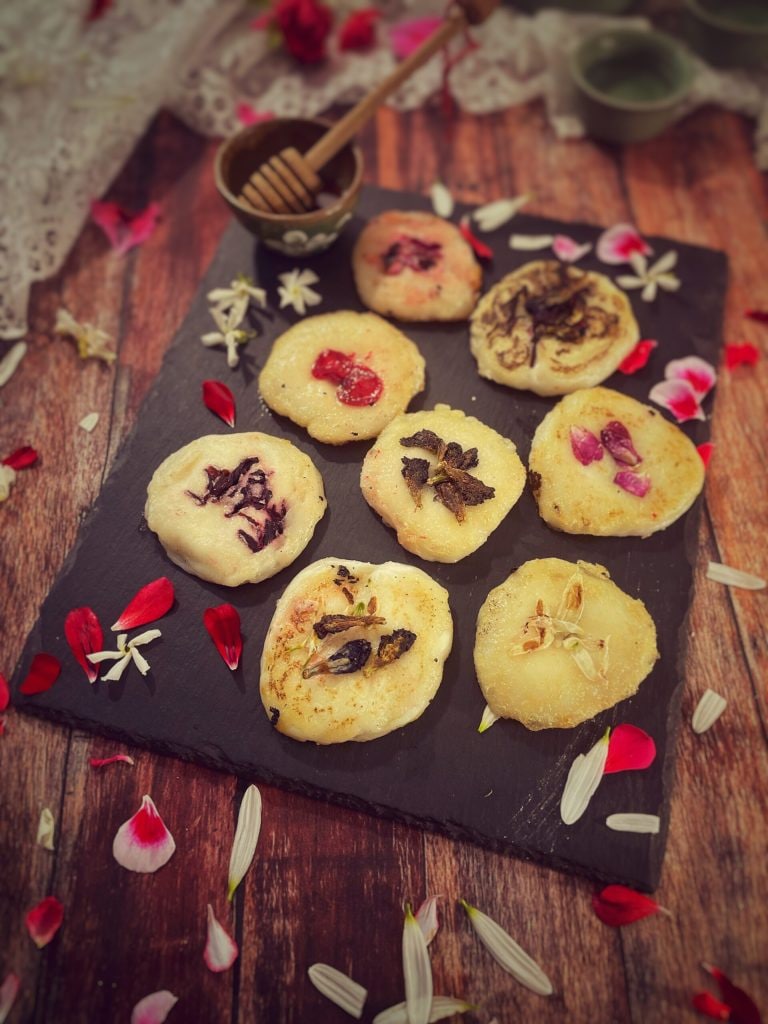Hwajeon (화전), or flower cake, is a small Korean rice cake pan-fried.
It is made with glutinous rice flour, honey, and edible seasonal flower petals and consumed during the Samjinnal and Buddha’s birthday celebrations.
The word “hwajeon” is a compound noun formed from the hanja hwa (화;花), meaning “flower”, and jeon (전;煎), meaning “a pan”.
The fried flower cakes are dipped in honey to add sweetness and often sprinkled with ground cinnamon.
There are two main methods to prepare hwajeon:
• The glutinous rice is seasoned with salt, pounded until a fine flour is obtained, and kneaded with boiling water.
The dough takes a small round and flat shape and is pan-fried in sesame oil.
The flower petals are placed and gently pressed on the dough while frying on the griddle.
• The fine glutinous rice flour is kneaded into a thick dough and rolled out into sheets 0.2 inches thick.
The flower petals are then placed on the dough, gently pressed, and the sheets are cut with hwajeon-tong, a tool similar to a cookie cutter, with a diameter of 2 inches.
The flower sweets are fried in sesame oil. This method was used in the Korean royal court cuisine.
The origins trace back to the Koryo dynasty. In the lunar calendar, March 3 marks the beginning of spring and is called Samjitnal.
This day is also known as “when the swallows return from the South” .
Royal historians also recorded that during the Samjitnal (삼짇날), the queen and princesses celebrated spring by playing and enjoying these treats along with the first flowers that bloom in spring.
On the blog you can find a menu dedicated entirely to edible flowers:

- Difficulty: Medium
- Cost: Economical
- Preparation time: 5 Minutes
- Portions: 12 Pieces
- Cooking methods: Frying
- Cuisine: Korean
- Seasonality: Autumn, Winter, and Spring
Ingredients
- 5.3 oz glutinous rice flour
- 0.5 cup boiling water
- 1 pinch salt
- to taste edible flowers
- to taste sesame oil
- to taste honey
- to taste cinnamon
Steps
In a bowl, mix the glutinous rice flour with salt.
Gradually add the boiling water, stirring with a spatula or wooden spoon, until a soft and workable dough is obtained.
When the dough is cool enough to handle, knead it with your hands until smooth.
Divide the dough into small portions (about 0.8-1.2 inches in diameter) and form balls.
Flatten each ball between your palms to achieve discs about 0.2 inches thick.
Gently clean the edible flower petals with a damp cloth.
Gently press the petals onto the surface of each dough disc, creating decorative patterns.
Heat a non-stick pan over medium-low heat and add some sesame oil.
Cook the pancakes for 1-2 minutes per side, until they become lightly golden.
Be careful not to burn the petals.
Arrange the pancakes on a serving plate.
Drizzle with honey and, if desired, sprinkle with a bit of ground cinnamon.
Serve warm or at room temperature.
Hwajeon nori
Hwajeon nori, which literally translates to “flower cake game”, is a tradition involving a picnic in the mountains to observe seasonal flowers during spring and autumn.
In spring, women used to go on a picnic, bringing glutinous rice flour and a griddle near a stream during Samjinnal, which falls every third day of the third lunar month of the Korean calendar.
They gathered edible spring flowers and prepared hwajeon.
The variety made with rhododendron is considered the most representative hwajeon, traditionally eaten with rhododendron punch, consisting of the same flower floating in honey water or magnolia berries.
Similarly, people enjoyed hwajeon nori in autumn, with hwajeon made with chrysanthemum flowers and leaves together with chrysanthemum wine or yuja punch.
The custom is closely related to Junggu, the traditional festival that falls on the ninth day of the ninth lunar month of the Korean calendar.
These customs date back to the Three Kingdoms era (57 B.C. – 668 A.D.) and originated in Silla.
These customs date back to the Three Kingdoms era (57 B.C. – 668 A.D.) and originated in Silla.

FAQ (Frequently Asked Questions)
What are the different varieties of hwajeon ?
Hwajeon is made from edible flower petals of the season (in Korea).
Typically, in spring, rhododendron, pear blossom, iris flower, cherry blossom, and violet are used; in summer, rose is used, and in autumn, chrysanthemum and cockscomb are used.
In winter, when flowers are scarce in Korea, alternatives like mugwort leaves, water parsley leaves, rock tripe, or jujubes are cut into flower shapes and used instead.
• Beotkkot-hwajeon (벚꽃화전) – cherry blossom
• Gaenari-hwajeon (개나리화전) – golden bellflower
• Gukhwa-jeon (국화전;菊花煎) – chrysanthemum
• Ihwa-jeon (이화전;梨花煎) or Baekkot-hwajeon (배꽃화전) – pear blossom
• Jangmi-hwajeon (장미화전;薔薇花煎) – rose
• Jebikkot-hwajeon (제비꽃화전) – violet
• Jindallae-hwajeon (진달래화전) or Dugyeonhwa-jeon (두견화전;杜鵑花煎) – rhododendron
• Maendurami-hwajeon (맨드라미화전) – cockscomb


